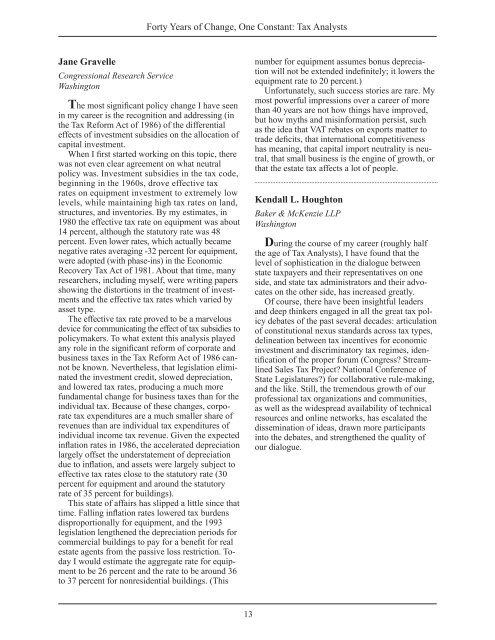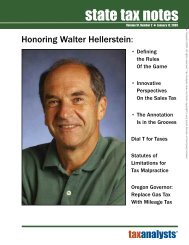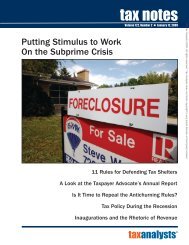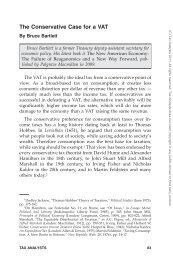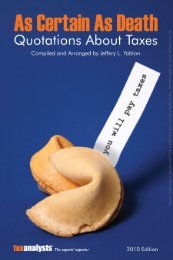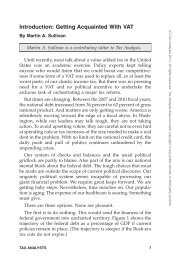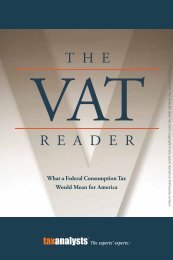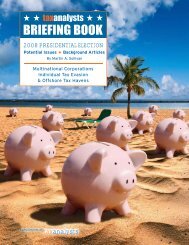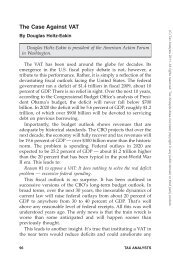Forty Years of Change, One Constant: Tax Analysts
Forty Years of Change, One Constant: Tax Analysts
Forty Years of Change, One Constant: Tax Analysts
You also want an ePaper? Increase the reach of your titles
YUMPU automatically turns print PDFs into web optimized ePapers that Google loves.
<strong>Forty</strong> <strong>Years</strong> <strong>of</strong> <strong>Change</strong>, <strong>One</strong> <strong>Constant</strong>: <strong>Tax</strong> <strong>Analysts</strong><br />
Jane Gravelle<br />
Congressional Research Service<br />
Washington<br />
The most significant policy change I have seen<br />
in my career is the recognition and addressing (in<br />
the <strong>Tax</strong> Reform Act <strong>of</strong> 1986) <strong>of</strong> the differential<br />
effects <strong>of</strong> investment subsidies on the allocation <strong>of</strong><br />
capital investment.<br />
When I first started working on this topic, there<br />
was not even clear agreement on what neutral<br />
policy was. Investment subsidies in the tax code,<br />
beginning in the 1960s, drove effective tax<br />
rates on equipment investment to extremely low<br />
levels, while maintaining high tax rates on land,<br />
structures, and inventories. By my estimates, in<br />
1980 the effective tax rate on equipment was about<br />
14 percent, although the statutory rate was 48<br />
percent. Even lower rates, which actually became<br />
negative rates averaging -32 percent for equipment,<br />
were adopted (with phase-ins) in the Economic<br />
Recovery <strong>Tax</strong> Act <strong>of</strong> 1981. About that time, many<br />
researchers, including myself, were writing papers<br />
showing the distortions in the treatment <strong>of</strong> investments<br />
and the effective tax rates which varied by<br />
asset type.<br />
The effective tax rate proved to be a marvelous<br />
device for communicating the effect <strong>of</strong> tax subsidies to<br />
policymakers. To what extent this analysis played<br />
any role in the significant reform <strong>of</strong> corporate and<br />
business taxes in the <strong>Tax</strong> Reform Act <strong>of</strong> 1986 cannot<br />
be known. Nevertheless, that legislation eliminated<br />
the investment credit, slowed depreciation,<br />
and lowered tax rates, producing a much more<br />
fundamental change for business taxes than for the<br />
individual tax. Because <strong>of</strong> these changes, corporate<br />
tax expenditures are a much smaller share <strong>of</strong><br />
revenues than are individual tax expenditures <strong>of</strong><br />
individual income tax revenue. Given the expected<br />
inflation rates in 1986, the accelerated depreciation<br />
largely <strong>of</strong>fset the understatement <strong>of</strong> depreciation<br />
due to inflation, and assets were largely subject to<br />
effective tax rates close to the statutory rate (30<br />
percent for equipment and around the statutory<br />
rate <strong>of</strong> 35 percent for buildings).<br />
This state <strong>of</strong> affairs has slipped a little since that<br />
time. Falling inflation rates lowered tax burdens<br />
disproportionally for equipment, and the 1993<br />
legislation lengthened the depreciation periods for<br />
commercial buildings to pay for a benefit for real<br />
estate agents from the passive loss restriction. Today<br />
I would estimate the aggregate rate for equipment<br />
to be 26 percent and the rate to be around 36<br />
to 37 percent for nonresidential buildings. (This<br />
number for equipment assumes bonus depreciation<br />
will not be extended indefinitely; it lowers the<br />
equipment rate to 20 percent.)<br />
Unfortunately, such success stories are rare. My<br />
most powerful impressions over a career <strong>of</strong> more<br />
than 40 years are not how things have improved,<br />
but how myths and misinformation persist, such<br />
as the idea that VAT rebates on exports matter to<br />
trade deficits, that international competitiveness<br />
has meaning, that capital import neutrality is neutral,<br />
that small business is the engine <strong>of</strong> growth, or<br />
that the estate tax affects a lot <strong>of</strong> people.<br />
Kendall L. Houghton<br />
Baker & McKenzie LLP<br />
Washington<br />
During the course <strong>of</strong> my career (roughly half<br />
the age <strong>of</strong> <strong>Tax</strong> <strong>Analysts</strong>), I have found that the<br />
level <strong>of</strong> sophistication in the dialogue between<br />
state taxpayers and their representatives on one<br />
side, and state tax administrators and their advocates<br />
on the other side, has increased greatly.<br />
Of course, there have been insightful leaders<br />
and deep thinkers engaged in all the great tax policy<br />
debates <strong>of</strong> the past several decades: articulation<br />
<strong>of</strong> constitutional nexus standards across tax types,<br />
delineation between tax incentives for economic<br />
investment and discriminatory tax regimes, identification<br />
<strong>of</strong> the proper forum (Congress? Streamlined<br />
Sales <strong>Tax</strong> Project? National Conference <strong>of</strong><br />
State Legislatures?) for collaborative rule-making,<br />
and the like. Still, the tremendous growth <strong>of</strong> our<br />
pr<strong>of</strong>essional tax organizations and communities,<br />
as well as the widespread availability <strong>of</strong> technical<br />
resources and online networks, has escalated the<br />
dissemination <strong>of</strong> ideas, drawn more participants<br />
into the debates, and strengthened the quality <strong>of</strong><br />
our dialogue.<br />
13


